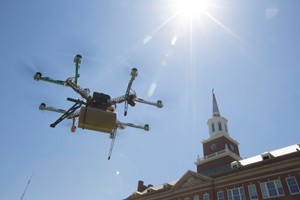
FAA Authorization Propels UC's UAV Work Skyward
The high-flying endeavors in unmanned aerial vehicle testing and research at the University of Cincinnati just got a new lift from the Federal Aviation Administration.
This week the FAA granted UC's
Department of Aerospace Engineering and Engineering Mechanics
and
Department of Mechanical and Materials Engineering
certificates of authorization (COA) to test five types of UAVs, or drones, in Wilmington Air Park, less than an hour's drive from campus. Permission to also fly with the West Virginia Division of Forestry is still pending.
This new development gives the university a
rare combination of FAA endorsement
(in many cases, flying a drone is illegal without it),
nearby testing facilities and innovative minds experienced in collaborating with industry partners
, according to professor Paul Orkwis, head of the Aerospace Engineering and Engineering Mechanics Department.
"There are going to be a lot of companies in the up-and-coming UAV business, but how can you be successful with it?" Orkwis says. "You have facilities that people want to use and you have minds that have ideas. That's what we can provide: smart people who care about this stuff and can help a company."
Faculty at UC's
College of Engineering and Applied Science
, namely professors Kelly Cohen and Manish Kumar, have been working with UAVs for years, but attention from government representatives increased late last year. Collaboration with the
led to sponsorship for the two-year FAA authorization, which can cost up to $25,000 per certificate, from the Ohio State Department of Transportation in addition to priority access to Wilmington Air Park.
Sponsorship and support from state government
enables UC with help from the
University of Cincinnati Research Institute
(UCRI), an independent nonprofit entity connecting UC experts to industry partners to offer a more economical option than other universities. It's a perk that's tough to match, says Cohen, professor of aerospace engineering and engineering mechanics.
"There are other universities that get COAs from the FAA. But they have to work out where they can fly. They cant shut down an airport. We have a unique situation in that Wilmington Air Park has the space, the facilities and the capabilities," Cohen says. "And when the state says, 'Im taking care of these guys,' now theres the advantage. Furthermore, this vital FAA approval will enable flight tests of the
with our partners
and UCRI."

UC students check on an octocopter drone
The COAs also will benefit the National Science Foundation-funded project titled Situational Awareness during Fire and Emergency (SAFE) being carried out at UC under the supervision of professors Cohen and Kumar. The project focuses on developing UAV-based solutions for generating situational awareness during large-scale disasters.
The COAs will enable outdoor flight tests in support of the prototype development in collaboration with the Cincinnati Fire Department and West Virginia Division of Forestry, Kumar says.
Furthering UC's uncommon advantage in this area of research is
the university's beneficial location amid what Orkwis calls the nation's aerospace hub
. GE Aviation, the world's biggest producer of aircraft engines, is a short distance from UC's campus; Wright Patterson Air Force Base, the center of U.S. Air Force research and development, is near Dayton, Ohio; the NASA Glenn Research Center is in Cleveland; and several private jet charter companies, including NetJets, are headquartered in Columbus, Ohio. Put it all together and you can make an interesting geographic comparison.
"UC and Ohio could be to the UAV industry what Stanford University and Silicon Valley are to the high-tech economic sector," Orkwis says.
Testing can begin immediately at Wilmington Air Park, and UC will continue supporting the West Virginia Division of Forestry with emergency-response efforts. Most of UC's work with UAVs involves smaller systems that bring innovation to areas such as commerce, search and rescue, wildfire suppression, package delivery, agriculture and sports event coverage.
Orkwis points out that oftentimes when industry benefits, so does the workforce.
"Doing research that goes on the shelf and gets published is beautiful. It's what we do as academics," Orkwis says. "But making jobs is when you take that research off the shelf and make it fly."
MORE ABOUT UC'S UAV RESEARCH
HorseFly 'Octocopter' Primed to Fly the Future to Your Front Door
UC collaborates with AMP Electric Vehicles to create the ultimate unmanned aerial vehicle for safely delivering goods.
Don't Fear the Dawn of the Drones Someday One Just Might Save Your Life, Thanks to UC Research
University of Cincinnati engineering researchers are finding new and unique approaches to developing autopilots for unmanned aerial vehicles and getting them into the hands of firefighters and other first responders.
.
UC Aerial Robot System Can Save Firefighter Lives
A system built by University of Cincinnati experts around an unmanned aerial vehicle has faced a real-world test in a West Virginia controlled forest burn, and proved its usefulness.
READ ABOUT HORSEFLY IN THE MEDIA
Popular Science: The Dream of Delivery Drones Is Alive (And On A Truck)
Wired: The Next Big Thing You Missed: Amazons Delivery Drones Could Work They Just Need Trucks
NPR's Car Talk: The Future of Package Delivery: A Hybrid Truck With Drone Backup
Fast Company-Design: Customizable Octocopter Wants To Be The Ultimate Delivery Drone
Fast Company-Exist: The Delivery Drone That Could Make Amazon's Vision A Reality
Related Stories
UC professor Ephraim Gutmark elected to National Academy of...
December 20, 2024
Ephraim Gutmark, distinguished professor of aerospace engineering at the University of Cincinnati, was elected to the 2024 class of the prestigious National Academy of Inventors.
UC students use 1819 Makerspace to build award-winning scoliosis...
December 18, 2024
Three University of Cincinnati students used the 1819 Ground Floor Makerspace to invent and test a groundbreaking treatment for pediatric scoliosis.
Chamberlain Group and the power of co-op
December 16, 2024
For two decades, the Chamberlain Group and UC have partnered on cooperative education experiences. Chamberlain Group, a global leader in intelligent access, provides hands-on experience for students in fields such as engineering, industrial design and communication design.
